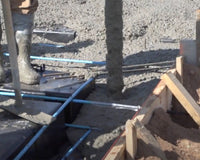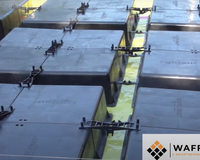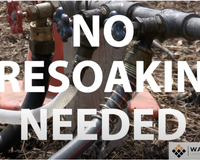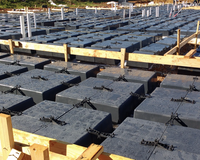The potential problem
A non-expansive soil cap on top of expansive soil may not always stop expansion of the underlying expansive soil, or the resulting damaging effects of on the foundations and structures built on top of the soil cap. However, if the foundations built on top of the soil cap are designed to be rigid enough to withstand differential vertical movements between the perimeter walls and the interior floors, the problem will not be structural. The problem may be higher cost.
Why should you care about this problem?
When placing a non-expansive soil cap on top of expansive soil, (1) the parameters of the underlying expansive soil must be fully known, (2) long term performance of the non-expansive soil cap on top of the underlying expansive soil must be accurately determined, (3) long-term foundation structural performance must be assessed, and (4) the increase in the cost of constructing the foundation caused by the use of a non-expansive soil cap must be calculated. You may end up spending a lot of money on a non-expansive soil cap that does not adequately mitigate the effects of the underlying expansive soil, or that may not be necessary if an alternative foundation system is used.
What happens to traditional foundation designs that are placed directly on expansive soil?
Three of the most common foundations designs—ribbed slab (RS), uniform thickness slab (UTS), and stem wall with continuous footing (SW)—do not mitigate the effects of expansive soil. The RS and UTS foundations are always in full contact with the soil. If the soil changes volume due to changes in the moisture content, these two types of foundations will move. The SW foundation allows expansion of soil into the air space area under the raised floor, but the footings may still be subject to the uplifting forces of deep expanding clay.

What happens to traditional foundation designs when they are placed directly on a non-expansive soil cap that is placed over expansive soil?
The non-expansive soil layer will transmit the upward force of the underlying expansive soil, if that upward force exceeds the combined weight of the non-expansive soil cap, foundation, and structure. There may also be differential vertical movements between the perimeter walls and the floors, due to the differences in gravity loads and foundation rigidities.
The Hawaiian Reinforced Slab (HRS) is an example of a foundation design that uses a non-expansive soil cap over expansive soil, overlain by a medium thickness floor slab with deepened perimeter beams for the foundation. This foundation design has been proven to work when placed on a properly engineered non-expansive soil cap. But, it can be a costly foundation solution when the cost of the soil cap is added to the total cost of the foundation.

Why is a non-expansive soil cap used?
Foundation designers often assume that a non-expansive soil cap is the best solution to many of their expansive soil problems. Such an assumption is not always correct. Depending on the characteristics of the expansive soil and its depth, the use of a non-expansive soil cap may or may not be the answer.
Expansive Soil with a Non-Expansive Soil Cap: Building Directly on Expansive Soil
What happens to a traditional foundation placed directly on expansive soil?
An example of this is the foundation design commonly used in low income housing in Mexico. Most house builders there do not have the soil tested for its expansive characteristics—they usually just concern themselves with the allowable soil bearing pressure (ASBP). The foundation is designed using only the ASBP and built directly on top of the expansive soil, without significantly thickening the perimeter grade beams and floor slab, and without adding structural reinforcement to the floor slab. The floor slab usually only has lightweight welded wire fabric (WWF), which is very flexible and is used only to minimize temperature cracking in the concrete. During the construction process, the WWF is walked on and ends up lying on the ground at the bottom of the foundation when the concrete is placed— thereby rendering it useless. After several wet and dry seasons, the foundation starts to heave, which eventually leads to structural cracking of the concrete.
Water easily migrates under the shallow edge beam and then under the thin slab of this foundation design, because there is little to stop it. The result is that soil expansion occurs further in from the edge of the slab.
Some house builders have used heavier reinforcement in the thin floor slab, but the entire area of the floor slab is still in contact with the expanding soil. The result is still the same—slab movement and structural cracking.

Thin expansive soil layer
If the uppermost layer of soil at the building site is expansive, and if it is not very thick, some geotechnical engineers may recommend the layer be completely removed and replaced with non- expansive soil. This solution solves all expansive soil problems, because it completely eliminates any potential for soil expansion and the resulting negative impact such expansion can have on the foundation and structure. However, it also requires a substantial cost to remove, dispose of, and replace the expansive soil with imported non-expansive soil.

Thick expansive soil layer
If the upper layer of soil is expansive and deep, removing all of the expansive soil over the depth subject to moisture variation in this layer may not be an economically feasible solution. In order to completely eliminate the expansion potential of the expansive soil, a significant depth of that soil might have to be removed and replaced with a non-expansive soil cap – a very expensive undertaking. In such cases, some foundation designs incorrectly assume that if you remove only a part of the upper layer of expansive soil that is subject to moisture variation, the effects of soil expansion will be avoided.
Sometimes that approach works, but, most often over time, it fails.
Why does it fail? Non-expansive soil caps are made from soils that have higher permeability than expansive soils. Surface and sub-surface water will flow much more quickly through the non-expansive soil cap material and migrate down by gravity to the top of the expansive soil. Water inundates the upper zone of the expansive soil. The expansive soil in that upper zone eventually becomes wetted below its interface with the non-expansive soil cap, and it expands.
Where does it expand? It expands upward against the underside of the non-expansive soil cap at the interface of the two different soil layers. If the upward force of the expansive soil exceeds the combined gravity loads of the soil cap, foundation, and the structure, the foundation will move upward.

Example of soil cap failure
In one large housing development in Northern Mexico, where the soil is highly expansive, the expansion pressure of the soil was tested using ASTM D 4546 (Method B) and found to be 32 psi (2.25 kg/sq cm/4608 psf). This testing was done as part of a post-construction forensic investigation and analysis of foundation failures at that site. Recommendations in the original soil study included placing a one meter thick non-expansive soil cap over the deep and highly expansive soil. The soil cap was made of material designed to mitigate soil expansion. A drilled concrete pier and grade beam foundation was used. It incorporated a thin UTS that was placed on top of the non-expansive soil cap and poured monolithically with the grade beams, which rested on top of the piers.
Within two years after the housing development was completed, most of the houses experienced significant heaving of the concrete floors inside the house. The expansive soil exerted uplift pressure on the non-expansive soil cap, which in turn transmitted uplift pressure to the concrete foundation and structure. The thin UTS was not designed for these upward forces, which resulted in significant vertical movement and cracking of the slab.
The non-expansive soil cap, with all of the time and expense that was involved in placing it over the entire project site, permitted rain and ground water to percolate down to the expansive soil below the soil cap.
Also, the expansive soil below the interface level with the soil cap was most likely not moisture conditioned before the soil cap was placed, resulting in even greater damaging expansion pressures at the base of the soil cap. Those pressures were transmitted by the soil cap to the foundation. The non- expansive soil cap, with a concrete pier and grade beam foundation, was not the correct solution for this project site, because it did not prevent damage to the foundation from the expansive soil.

How do foundation designs perform on a soil cap?
UTS, RS, and HRS foundations do not mitigate upward expansion force in the soil. They move with the expanding soil. The SW foundation (and foundations using drilled piers with grade beams), where the floors are elevated above the ground level, can avoid this upward expansion force, but at a significantly greater cost. They also have other problems such as keeping the open area under the house dry during the rainy season. Perimeter drains are usually required around the foundation, as well as foundation perimeter vents, in order to ensure that the open area under the house is kept dry and ventilated, and free of mildew.
One foundation system that is designed for use directly on expansive soils is the Wafflemat™ System. The Wafflemat System utilizes sacrificial plastic forms to create voids on the underside of the foundation slab. The Wafflemat foundation sits directly on the ground, usually with no soil treatment or other preparation of the soil required, other than to grade a suitable flat building pad.
The Wafflemat System has been successfully used since the early 1990’s. It works by simply absorbing the expanding clay soil into the voids. A grid of narrow reinforced beams contacts the ground, thereby presenting significantly less contact area upon which the expansive soil can exert its uplifting force, yet still maintaining ASBP. The Wafflemat foundation also creates a much more rigid matrix of beams that resist the bending forces exerted on the foundation by the upwardly expanding soil. The closer spacing of the beams allows the thin slabs that span over the Waffleboxes between the beams to provide an overall structural cross section with the required rigidity. Floor slab deflections are minimal and structural cracking is almost non-existent.
What does a Wafflemat foundation look like? Imagine that you are standing in a modern concrete parking garage. Look upward. Most likely, the structural floor system that you see will look like a waffle. The floor will have rigid beams running in perpendicular directions to each other, with voids in between the beams. If that floor was placed on a prepared building pad, it would be very similar to the Wafflemat System.
What happens to the soil under the Wafflemat System? When the expansive soil gets wet it expands upward. It makes contact with the narrow beams of the Wafflemat, and then slides outward and upward around the edges of the beams and into the voids created by the Waffleboxes. The expansive energy of the soil is partially dissipated into those voids. The result is that much less upward force of soil expansion is transmitted to the underside of the Wafflemat foundation. In contrast, the RS and UTS foundations will feel the full brunt of the expansion force of the soil.

Advantages of using a non-expansive soil cap
· If the expansive soil layer is thin, removing all of the expansive soil and replacing it with a non- expansive soil cap completely eliminates the soil expansion problem. Depending on the thickness of the expansive soil layer, this may be the best total cost solution.
· The properties of the soil cap can be engineered by the geotechnical engineer.
Disadvantages of using a non-expansive soil cap?
· A non-expansive soil cap on deep expansive soil will most often not eliminate the expansion problems of the underlying expansive soil, especially when the depth of the expansive soil with unstable moisture content is deep, and when lightweight one-story or two-story homes with wood frame construction are built on the foundations.
· The costs of (1) excavating, off-hauling, and disposing of the expansive soil, (2) purchasing the replacement non-expansive soil, and (3) importing and re-compacting the non-expansive soil can be very high.
· The in-situ soil may consolidate under the increased load of the non-expansive cap.
· The carbon footprint is substantially increased due to the additional trucking required for soil export and import, and due to the heavy construction equipment required for the necessary earthwork.
· Ground water and rainwater will still percolate through the permeable non-expansive soil cap and migrate down to the underlying expansive soil, where expansion of that soil may take place over time.
· A geotechnical engineer will need to test the soil cap after placement and compaction, in order to ensure that the soil parameters of the soil cap meet the geotechnical design specifications.
Conclusions
UTS, RS, and HRS foundations will not absorb any of the upward forces generated by expansive soil that exceed the total gravity load of the soil cap, foundation, and structure. These foundations are in full contact with the soil. Above the equilibrium point for all vertical loads, these foundations will move upward. These foundations only resist the bending and cracking effects of the upward forces by their structural design rigidities. The RS and HRS foundations, however, also require excavation of the soil cap for the in-ground ribs that are used to provide rigidity for their slabs. The excavation requires additional cost and time.
The SW foundation (and foundations using drilled piers with elevated grade beams and a raised floor) generally will avoid the forces of expanding soil, as long as the bottoms of the buried parts of the foundation rest on expansive soil that does not experience moisture variation or on soil that is non- expansive. Expanding soil can also exert an upward force on the buried surfaces of drilled piers and stem walls. The SW foundation also has considerable expense and time required for excavating, forming, and pouring the concrete supports, removing and disposing of the soil, and framing the raised floor.
The Wafflemat is specifically designed to absorb pressures from expanding soil. It is built directly on the expansive soil of the prepared building pad in the same manner as the UTS. No additional excavation and import of soil is required with the Wafflemat System, just as it is not required with the UTS. The time of construction for the Wafflemat System is comparable to the construction time for the UTS. The Wafflemat slab, however, is more rigid per cubic yard of concrete and will absorb expanding soil and partially dissipate soil expansion pressures. In addition, the Wafflemat System has a very low carbon footprint, because it does not require excavation and/or import of soil as is required for the RS, HRS, and SW foundations; and it also uses recycled plastic in the fabrication of the Waffleboxes that form the voids in the Wafflemat System foundation.





